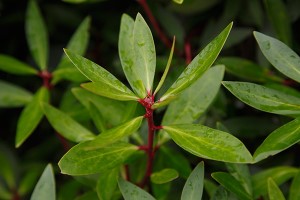- Houseplants
- 4,659
Cumquat, or Citrus japonica, is a small citrus tree native to China and Japan, and is a popular garden plant in many parts of the world. The tree produces small, orange fruit that can be eaten raw or cooked, and its fragrant flowers make it a pleasant addition to any garden or patio. It can also be grown in Australia.
Here at Garden Pie, we'll show you how to grow and care for a cumquat tree.
Table of contents [Show]
- 1 What you need to know about cumquat trees
- 2 Appearance and characteristics of cumquat trees
- 3 Varieties of cumquat trees
- 4 Uses for cumquats
- 5 Steps to grow a cumquat tree
- 6 Caring for cumquat trees
- 7 How often should you water and feed a cumquat tree ?
- 8 How and when to harvest cumquats ?
- 9 Diseases and pests that affect cumquats
- 10 How to propagate a cumquat tree ?
What you need to know about cumquat trees
Cumquat trees are a unique and beautiful addition to any garden or landscape. Native to southeastern Asia, the small, round fruits that these trees produce have a unique flavor that is loved by many.
For those interested in growing cumquat trees, there are a few important things to know.
First and foremost, cumquat trees require a lot of sunshine. The trees thrive in full sun and should be placed in an area that receives at least eight hours of direct sunlight each day. The trees also need well-draining soil that is rich in organic matter.
Cumquat trees should be watered deeply and regularly. The soil should be kept moist but not soggy. If the soil is allowed to become too dry, the leaves of the tree will start to yellow and drop off.
Fertilizing is also important. A balanced fertilizer should be applied every few months to keep the tree healthy and vigorous.
Pruning is essential for the health of the cumquat tree. Prune the tree regularly to remove dead, diseased, or damaged branches. This will encourage new growth and help keep the tree from becoming overgrown.
Harvesting the fruit can be tricky. The fruits are ripe when they are bright orange in color. If the fruit is still green, it is not yet ripe and should be left on the tree. Care should be taken when harvesting to ensure that the fruit does not get damaged.
Facts you need to know about cumquat trees includes:
- Name: cumquat, kumquat, Meiwa cumquat (Citrus crassifolia or Fortunella crassifolia), Nagami cumquat (Fortunella margarita), Marumi cumquat (Fortunella japonica).
- Height: 1-3m.
- Plant type: evergreen tree.
- Climate: subtropical, cool and warm-temperate, and arid.
- Soil: moist, well-drained, enriched with plenty of organic matter.
- Position: full sun.
- Foliage: shiny, dark-green leaves, fragrant when crushed.
- Flowering and fruiting: masses of small, white, fragrant, star-shaped flowers in spring and summer, followed by bright-orange round or oval fruit from autumn through winter.
- Feeding: citrus are hungry plants; feed each season with a complete organic fertiliser, but not when they're in flower.
- Watering: water regularly, especially when flowering and fruiting.
Appearance and characteristics of cumquat trees
Cumquats are prized for their fragrant, sweet-tart fruit, which can be used fresh, cooked, or preserved.
Appearance
- Cumquat trees are small, typically reaching no more than 8 feet in height.
- They have a round or oval-shaped canopy with glossy, dark green leaves.
- The branches of the tree grow in an upright manner, and the trunk is usually short and stout.
- The flowers of the tree are white and fragrant, and the edible fruits are small and round, with a bright orange to yellow color.
Characteristics
- Cumquat trees are hardy and can tolerate a variety of growing conditions, including full sun and partial shade.
- The trees are also drought-tolerant, making them a good choice for climates with low rainfall.
- Cumquats are also relatively pest-resistant, and they are not prone to many diseases.
- The fruits of cumquat trees are usually harvested in the autumn or winter months. The fruit can be eaten fresh, cooked, or preserved.
- The juice of the fruit can also be used as a flavoring or as a souring agent in recipes.
- The leaves and flowers of the cumquat tree are also edible, and they can be used to make herbal teas and infusions.
Varieties of cumquat trees
There are several varieties of cumquat trees, each with its own unique characteristics:
- One of the most popular varieties is the Nagami cumquat tree, which is native to China and Japan. This tree produces oval-shaped fruit that has a yellow-orange color and a juicy, sweet-tart flavor. The Nagami cumquat tree is also known for producing a large crop of fruit that ripens in late winter and spring.
- The Meiwa cumquat tree is another popular variety, and is native to Japan. This tree produces round, bright orange fruits with a sweet-tart flavor. Meiwa cumquats ripen in late winter and early spring, and are often used to make jams and jellies.
- The Imperial cumquat tree is native to China, and produces oblong fruits that are yellow-orange in color. These fruits have a sweet-tart flavor, and ripen in late winter to early spring. The Imperial cumquat tree is often used for making jams and jellies, as well as for juicing.
Uses for cumquats
Cumquats have a unique tangy flavor and a bright orange color, and can be used in a variety of ways.
Here are some of the most popular uses for cumquats:
- Eating Raw: One of the most common and simple ways to enjoy cumquats is to eat them raw. They can be eaten as a snack, added to salads, or used as a garnish.
- Cooking: Cumquats can be used to make jams, jellies, and marmalades. They can also be used in baking, such as in cakes, cookies, and muffins. They can also be added to stews and sauces.
- Infusing Liquor: Cumquats can be used to infuse vodka, gin, and other spirits, as well as to make cordials.
- Flavoring Tea: Cumquats can be used to flavor tea, either by adding the pieces of fruit directly into the cup or by making a cumquat syrup that can be added to the tea.
- Making Syrups: Cumquats can be used to make a flavorful syrup that can be added to drinks or used as a topping for desserts.
- Making Candied Cumquats: Candied cumquats are a delicious treat, and can be made by boiling the cumquats in a simple syrup and then rolling them in sugar.
- Flavoring Desserts: The unique flavor of cumquats can be used to flavor a variety of desserts, such as ice cream, puddings, and custards.
Steps to grow a cumquat tree
While Cumquat trees are a great source of vitamin C and minerals, they are also relatively easy to grow.
To get started, here are the steps to growing your own cumquat tree:
1. Purchase your cumquat tree
Cumquat trees are available in a variety of sizes, so make sure you get one that is appropriate for the space you have. Look for a healthy tree with vibrant green leaves and a strong root system.
2. Plant your tree in a sunny, well-drained spot
Be sure to dig a hole that is twice as deep and twice as wide as the root ball. Add some compost or fertilizer to the hole before planting, and then fill the hole with soil.
3. Water your tree regularly
Cumquat trees need a lot of water to stay healthy and produce fruit, so make sure you water it at least twice a week during the growing season.
4. Fertilize your tree
Fertilize your cumquat tree every few months with a balanced fertilizer to ensure it has all the nutrients it needs to stay healthy and produce a good crop of fruit.
5. Prune your tree
Prune your tree regularly to keep it healthy and to encourage fruit production. Remove any dead or damaged branches and thin out the canopy to allow for more light and air circulation.
6. Protect your tree from pests and diseases
Monitor your tree for any pests or diseases and take steps to prevent them from spreading. If you spot any pests or diseases, treat the tree with an appropriate pesticide or fungicide.
Caring for cumquat trees
Proper care for a cumquat tree should be taken to ensure that the tree is healthy and productive.
Choose the right variety
There are many different types of cumquat trees, and some are better suited to certain climates than others. Be sure to consult with your local nursery or garden center to determine the best variety for your area.
Provide the proper environment for the tree to thrive
Cumquat trees prefer full sun and well-drained soil. Make sure to water the tree regularly, and fertilize it occasionally to ensure that it has enough nutrients.
Pruning
Regular pruning will help to maintain the tree's shape and encourage new growth. Pruning should be done when the tree is dormant, usually in late winter or early spring.
Harvesting
The fruit should be picked when it is ripe, usually when it is a deep orange color. Unripe fruit can be left on the tree to ripen.
How often should you water and feed a cumquat tree ?
In order to ensure that your tree produces a healthy crop of cumquats, it is important to understand the tree's needs for water and fertilizer.
Watering
Cumquat trees require regular watering but do not tolerate having their roots constantly wet.
- The best way to water your tree is to give it a deep watering once or twice a week.
- To do this, use a garden hose to thoroughly water the tree’s root zone, which should extend out to the drip line—the area beneath the outermost branches.
- Allow the water to percolate down several inches into the soil.
- During periods of extreme heat or drought, you may need to water your tree more frequently.
Fertilizing
Cumquat trees do not require a lot of fertilizer, but they do need some supplemental nutrients to produce healthy foliage and fruits.
- Apply a balanced fertilizer (such as 10-10-10) at the beginning of the growing season, then again in midsummer and early fall.
- Spread the fertilizer evenly around the tree's root zone.
- For mature trees, use 2 to 3 pounds of fertilizer for every inch of the tree's trunk diameter.
It is important to be mindful of the amount of fertilizer you use; too much can burn the tree's roots and damage its health. If you notice any signs of nutrient deficiency in your tree’s foliage (such as yellowing or wilting), you may need to apply a fertilizer with a higher nitrogen content.
How and when to harvest cumquats ?
Harvesting cumquats is an essential part of the process for getting the most flavor and nutrition out of them.
When to Harvest
The best time to harvest cumquats is when they are fully ripe in the late fall or early winter. The fruits should be a deep orange color, firm, and fragrant. If they are still green, they are not yet ready to be harvested.
How to Harvest
When harvesting cumquats, it is important to use pruning shears or scissors, as pulling them by hand can damage the fragile skin and lead to bruising or rotting. You should also be careful not to damage the branches of the tree or damage any of the other fruits.
Once the cumquats are harvested, it is important to store them in a cool, dry place. If you plan to use them immediately, it is best to eat them within a few days. If you want to store them for a longer period of time, it is best to freeze them in an airtight container.
Diseases and pests that affect cumquats
Cumquats are a popular fruit that are widely enjoyed for their sweet and tart flavor. However, like any other fruit, cumquats are vulnerable to a variety of diseases and pests that can affect their growth and production. It is important for growers to be aware of these threats in order to take the necessary steps to protect their crops.
Diseases
Cumquat trees are susceptible to a number of fungal diseases, such as powdery mildew, sooty mold and anthracnose.
- Powdery mildew appears as a white powdery coating on the leaves and stems, while sooty mold appears as a black or gray coating on the leaves and fruit.
- Anthracnose is a fungal disease that causes lesions on the fruit.
- Other diseases that can affect cumquats include Phytophthora root rot, root knot nematodes and citrus canker.
Pests
- Cumquats can also be affected by a variety of pests, including aphids, mites, scales and thrips. Aphids are small, soft-bodied insects that feed on the sap of the cumquat tree and can cause stunted growth and leaf distortion.
- Mites are tiny arachnids that feed on the leaves and can cause yellowing and leaf drop.
- Scales are small insects that produce waxy secretions on the leaves and fruit of the cumquat tree, while thrips are small, slender insects that can cause discoloration and scarring on the fruit.
Prevention and Treatment
- The best way to prevent diseases and pests from affecting cumquats is to practice good cultural practices, such as proper pruning, irrigation and fertilization.
- Growers should also inspect their trees regularly for signs of pests or diseases and remove any affected branches or fruit.
- If pests or diseases are present, growers should use the appropriate chemical treatments to control them.
How to propagate a cumquat tree ?
If you're looking to start your own cumquat tree, propagating it from an existing tree is the best way to go.
Here are some tips for propagating a cumquat tree:
1. Choose a healthy tree
If you're going to propagate a cumquat tree, you want to start with a healthy specimen. Look for a tree with lush foliage and no signs of disease or insect damage.
2. Take cuttings
The best way to propagate a cumquat tree is to take cuttings from the existing tree. Cut off a few healthy branches with several leaves attached. Make sure they're at least 6-8 inches long.
3. Prepare the cuttings
Dip the cuttings in a rooting hormone and then place them in a pot filled with moist, well-draining soil. You can also use a mixture of perlite and peat moss or sand.
4. Protect the cuttings
Cover the pot with a plastic bag or dome to keep the cuttings from drying out. Place the pot in a warm, sunny location and make sure to water the cuttings regularly.
5. Take care of the tree
Once the cuttings have rooted and the tree has started to grow, you'll need to provide it with regular care. This includes fertilizing, pruning, and protecting it from pests and diseases.
Conclusion
With a few simple steps explained in this guide, you can have your own cumquat tree in no time. In fact, Cumquat trees are a great addition to any Australian garden and are relatively easy to grow and maintain.
These small trees are well suited to a range of climates and provide a burst of colour to any outdoor space.
Tips to consider when growing cumquat tree
Growing a cumquat tree can be a rewarding experience, but it's important to follow the right steps to ensure its success.
Here are a few tips to consider when growing cumquat tree:
- Plant your cumquat tree in a sunny spot with well-draining soil.
- Space your cumquat trees at least 10 feet apart to give them enough room to spread.
- Water your cumquat tree regularly and deeply.
- Fertilize your cumquat tree with a balanced fertilizer at least twice a year.
- Prune your cumquat tree to encourage growth and reduce the risk of disease and pests.
- Check your cumquat tree regularly for signs of disease and pests.
- Mulch around the base of your cumquat tree to help retain moisture and reduce weeds.
- If growing your cumquat tree in a container, repot it every two to three years.
- Protect your cumquat tree from frost and cold temperatures by placing it in a sheltered area.
- Harvest your cumquat tree when the fruit is bright orange and slightly soft.
- Store your cumquat fruits in a cool, dry place away from direct sunlight.
- Avoid overwatering your cumquat tree as this can lead to root rot and other diseases.
- Plant companion plants near your cumquat tree to help attract beneficial insects and pollinators.
- If you notice any signs of disease or pests, treat them immediately.




